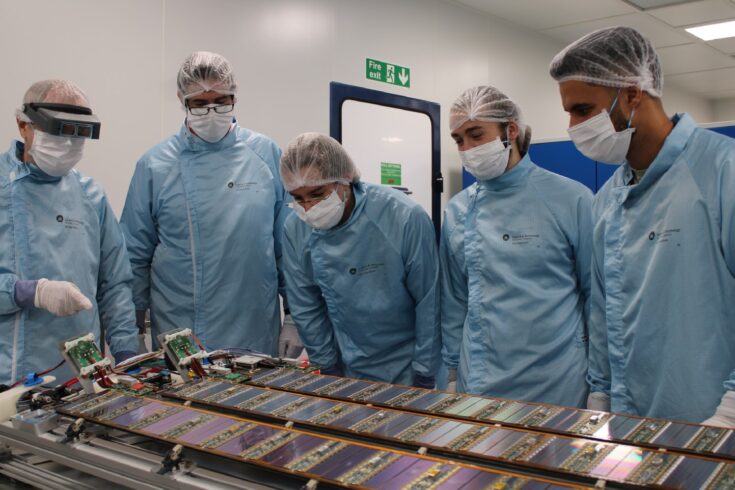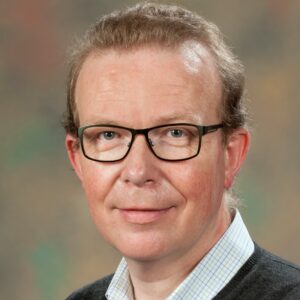Detectors and instrumentation are essential tools in the research of the Science and Technology Facilities Council (STFC) and the wider UK research community. They are the ‘eyes of our science’ that enable our researchers and scientific users to observe and measure the world in ways far beyond the capabilities of our senses.
In combination with the work of our accelerator developer cousins, who design and build the machines that drive the sources in our facilities, our instrumentation systems deliver the ‘image’ that allows us to observe and record our experiments. This enables our researchers to explore, test hypotheses and deliver breakthrough discovery.

Credit: CERN
The productivity of our researchers is only as good as the tools they have at their disposal. In recent years, the instrumentation needs of our research communities have grown substantially. Machine power and our investigation techniques have also come on in leaps and bounds, creating ever more information for us to record, store and analyse.
At the same time, across the scientific, engineering and medical disciplines, interdisciplinary research has also advanced. This has led to instruments that were once of interest only to specialists in one field becoming relied upon by a wide array of scientists in order to solve critical research problems in many different fields.
This wider application of instrumentation has meant that our detectors and instrumentation technology skills have become increasingly important. And since the formation of UK Research and Innovation (UKRI) in 2018, realising the value of combining the research councils has also never been more important.
Mission critical
For the UK, the ATLAS detector at CERN is our largest instrumentation system at 46m long and 25m high. Working with international teams, we are delivering breakthroughs in the understanding of the Higgs boson thanks to this detector.
In this one structure alone, over a billion particle interactions take place every second and the detectors and instrumentation have the job of analysing, sorting and accurately measuring their momentum and trajectories.
It is made up of six different detecting subsystems that record the trajectory, momentum and energy of particles, allowing them to be individually identified and measured. The UK has outstanding staff that contribute to this project in almost every area.
In 2022, high luminosity will begin running on ATLAS and will increase particle rates by almost a further factor of 10, requiring new instruments and systems. To meet this increase in data being produced, our teams are upgrading the ATLAS experiment in order to multiply the capacity of the systems to process data. One key step on that road is the calorimeter trigger.
The UK is leading in developing hardware systems that watch the calorimeter data in real-time and search for signatures of interesting physics to store and analyse. Each processing card designed at STFC’s Rutherford Appleton Laboratory (RAL), together with our university colleagues, processes over one tera-bit of scientific data every second.
To put that into context, it is the equivalent of 40 days’ worth of video footage. To date, a quarter of the whole system is already installed at CERN and the rest is on its way.

Credit: STFC
Similarly, our robust instrumentation systems have been applied to many other STFC fields including photon science and our neutron systems. For example, our scientific space missions all need instrumentation. In one recent example was the Solar Dynamics Observatory project, the UK designed and built imaging cameras for two of the three observatory’s instruments.
This was a NASA initiative designed to respond to the need to monitor the disruptive influence of the Sun. These have advanced our understanding of the physics of the Sun’s atmosphere and how it drives our space weather.
In this case, low noise radiation-hardened analogue system design techniques, developed in STFC for particle physics, enabled the design of low noise robust electronics that have survived reliably for more than a decade in the harsh radiation environment of space. STFC teams in Technology and RAL Space worked with UK industry-leaders Teledyne e2v to provide the complete imaging system.
Not just our large scientific facilities
Although our detectors are key to capturing the data from high power sources, they also have applications in many other areas.
On a much smaller laboratory scale, next-generation transmission microscope systems that use electrons rather than visible light to image are enabling our research teams to image individual biological molecules.
In this rapidly advancing field, the advanced imaging technology allows us to see structures only two angstroms across (an angstrom is one hundred millionth of a centimetre). This permits the analysis and measurement of protein structures otherwise impossible to unravel.
These systems all rely on high-performance imaging cameras that can survive the bombardment of electrons, image and process the projected high energy electrons. This is an example of technology developed for other fields being applied to life sciences delivering disruptive advances.
Today, in partnership with the Rosalind Franklin Institute, STFC engineers are also working to improve the electron microscope systems by building next-generation lower energy systems which will do less damage to valuable samples.
The goal is to deliver the same science capability but with simpler and more accessible systems to multiply the impact and capacity of the technique.
Future-proofing
But it isn’t just the existing technology that’s important. We need to plan ahead for future projects, even for projects we don’t yet know about.
Because the performance of our sensors often set the limits of what new facilities and experiments can deliver, if we wait for projects to start it is then too late to optimise the facility builds and realise their full potential.
This argument was the driver behind the centre for instrumentation programme, where a formal horizon scanning process selects the key instrumentation challenges that we are seeking to address so we are ready and can fully support the needs of our communities moving forward.
It’s not just the hardware, though. To maintain the UK’s position of leadership and keep our scientific advances flowing, we are prioritising training. The aim is to ensure that our technicians, engineers and future technicians coming through the apprenticeship scheme are equipped with the skills and knowledge needed to keep extending our impact in this exciting field.
Recent UKRI investments are all examples of new facilities that need next generation technologies, such as:
- the Rosalind Franklin Institute
- the Extreme Photonics Applications Centre
- the National Quantum Computing Centre.
STFC’s role
The outstanding UK teams, including the national labs of STFC and our university partners, are highly valued international collaborators on major research activities.
With STFC’s new Detectors and Instrumentation Strategy, we are recognising the significance of this discipline and really driving home how it underpins the STFC strategy. We show just how critical detectors and instrumentation are to every one of STFC’s key strategic goals and so must be managed and invested in.
A key action is to recognise that disparate groups working independently are no longer viable in this field and that a connected ‘hub and spoke’ method of linking work to ensure we work together constructively is now mandatory. This model is being mirrored internationally in other countries, and a recent review of instrumentation development in the wider particle physics community is coming up with similar recommendations.
STFC has an outstanding team of committed engineers working behind the scenes to make this happen. It’s a terrific field to work in, with many rewarding projects to engage with and the potential to support many more in the future.
Top image: Credit: STFC




